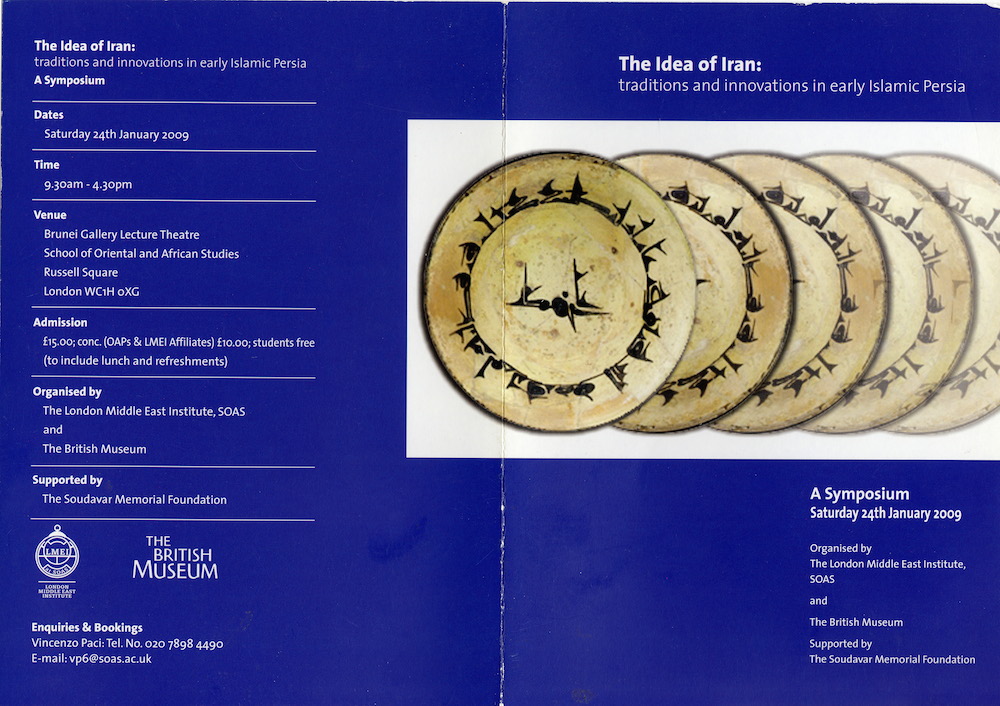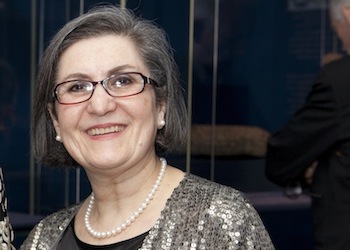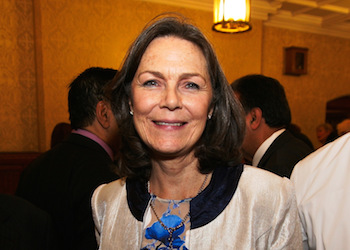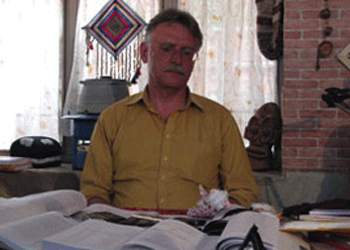The Idea of Iran: Traditions and Innovations in Early Islamic Persia

he sixth in the series of ‘The Idea of Iran’ was held as a one-day symposium at which contributions by six eminent scholars discussed traditions and innovations in early Islamic Persia.
Convenors

Dr Vesta Sarkhosh Curtis is Curator of Middle Eastern Coins at the British Museum and is responsible for its collection of pre-Islamic Iranian coins (from the third-century BC until the middle of the seventh-century AD), which includes both Parthian and Sasanian coins. She also looks after coins of the Islamic world beginning with the Umayyad and Abbasid periods and including coins of the Samanid and Buyid, Seljuk, Mamluk, Ayyubid and Fatimid, Ilkhanid and Timurid, Safavid and Qajar dynasties. Projected have included The Sasanian Coin Project, a collaborative project with the National Museum of Iran in Tehran, and now successfully completed. The result is a two-volume Sylloge of Sasanian coins of the third- to seventh-centuries AD while Dr Sarkhosh Curtis currently jointly-directs the International Parthian Coin Project, The Sylloge Nummorum Parthicorum (SNP), and is Joint Editor of the SNP series. This multi-institutional project will record Parthian coins of the third-century BC to the third-century AD found in London, Vienna, Tehran, Paris, Berlin, and the American Numismatic Society, New York.

Dr Sarah Stewart is Lecturer in Zoroastrianism in the Department of the Study of Religions at the School of Oriental and African Studies, University of London and Deputy Director of the London Middle East Institute, also at SOAS. She has been co-convenor of the ‘Idea of Iran’ symposia since its inception in 2006 and has co-edited five volumes in the ‘Idea of Iran’ publication series with I.B.Tauris. She serves on the Academic Council of the Iran Heritage Foundation and has been a longstanding Fellow of the British Institute of Persian Studies, most recently serving as its Honorary Secretary until 2013, in which year Dr Stewart co-organised the acclaimed exhibition: ‘The Everlasting Flame: Zoroastrianism in History and Imagination’. Her publications include studies on Parsi and Iranian-Zoroastrian living traditions and is currently working on a publication (in collaboration with Mandana Moavenat) on contemporary Zoroastrianism in Iran.
Speakers

The Good, the Bad, and the Beautiful: Survivals of Ancient Concepts in Persian popular Tales of the Islamic Period
Ulrich Marzolph, Professor of Islamic Studies, Georg-August-University, Göttingen and Enzyklopädie des Märchens
Historically, Iran is the cradle of or the starting point for the international dissemination of several highly influential collections of tales, including the mirror for princes Sanbad-name, the collection of fables, Kalila wa-Dimna, and the all-embracing frame tale known as The Thousand and One Nights. Various specific tales of ancient Iranian origin have become part of world literary tradition, such as the tale of Turandot as popularised by Carlo Gozzi, or the tale of the Princess and the Pea as published by Hans Christian Andersen. Moreover, in Arabic popular tradition of the Islamic period, ancient Iran is stereotypically conceived as the realm of myth and legend characterised by magic and all kinds of supernatural beings. Against the backdrop of these varied views, I propose to take a closer look at the extent to which persian narratives of the Islamic period are governed by ancient concepts, most of which ultimately relate to Zoroastrian tradition. While touching on the Iranian national epic, the Shahname, my focus is on modern Persian popular tales. Here we find a triadic group of characters serving as the stereotypical representations of the Good, the Bad, and the Beautiful. Deriving ultimately from ancient concepts, all these characters have undergone decisive developments over time.

Philosophy and the Iranian Intellectual Worldview
Hossein Ziai, Professor of Iranian and Islamic Studies, and Director of Iranian Studies, University of California Los Angeles
This paper will examine the origins and developments of philosophy in the Iranian-Islamic world. It will commence by presenting an overview of the Greek philosophical text that impacted the rise of philosophy in Arabic and Persian and will then go on to discuss the main philosophical themes that form the core of Islamic Peripatetic philosophy. The presentation will conclude with an explanation of how a new system of philosophy constructed by the Persian creative thinker, Shihab al-Din Sohravardi, in the twelfth-century, departs from the Aristotelian principles of intellectual knowledge. Sohravardi constructed a unified epistemological theory, named “Knowledge by Presence”, where acts of the self-conscious “I”, as an immediate and intuitive mode of cognition, obtain the primary principles of knowledge. This epistemological theory is instrumental in defining Persian poetic wisdom, and may help us better understand the principle position of poetry as the end of philosophy in what constitutes Iranian identity.

The Arts in or of Iran in Late Antiquity (600 to 1000)
Oleg Grabar, Emeritus Professor, School of Historical Studies, Institute for Advanced Study, Princeton University
The study of the arts of Iran in Late Antiquity is complicated by several factors. There is the complex history of the cultural and social relations between several dynasties in different areas. Then the physical extent of the land known as Iran which is difficult to determine, especially with respect to its eastern and western borders, and which should not be confused with the contemporary space known as Iran. Most importantly, there is a lack of commonality between the visual or visually-related documents we possess. There are objects, usually found all over the Eurasian world, rightly or wrongly associated with this period and with iran; archaeologically retrieved documents, in large quantities for the northeastern provinces but scant elsewhere; written sources; identifications or description of monuments, and all sorts of direct or indirect references which affect our understanding the nature of the material culture and how it was used. Finally, there are hypotheses which can be derived from the more coherent artistic developments of later times although these too are problematic. My paper will sketch some of the units of information which exist, including Sasanian architecture and objects, “para”-Sasanian objects, Soghd and Transoxiana, Afghanistan and Khorasan, Fars, northern Iran. I shall ask whether it is appropriate to talk of an “Iranian” art during these centuries or of several artistic movement in an Iranian land.
Transformations of the Snake-man: Myth, Language, and Iranian Identity
Martin Schwartz, Professor of Iranian Studies, Department of Near Eastern Studies, University of California Berkeley
This paper will address three interweaving strands: (1) The history of the Snake-man, called in Avestan Azhi Dahaaka, as the Other, the outsider opposed to the interests of Iranian identity – perhaps first among early settled Iranian who regarded him as the Daha barbarian, then in Younger Avestan as the representative of Babylon, subsequently in early Armenian, as the draconic Median enemy of Cyrus: in Pahlavi and New Persian as the Jewish revealer of false religion, and most importantly for the presentation at hand, in Firdausi, where he is the cannibalistic Arab usurper-tyran “Zahaak” (in Arabic script – modern Persian and Kurdish aspects of the myth will also be touched upon). (2) The interplay of language, mythopoeia, and ideology. (3) The adaptation of the Arabic script for Persian as a marker of a new Iranian identity, and the discrepancies with realities of the Arabic language. All three strands come together as one in the details of Firdausi.

Sandbad-name: A Zurvanite Cosmogonic Legend
Mohsen Zakeri, Research Fellow, University of Frankfurt
Cosmogony (afarinish) is understood to mean an account of how the universe came into being. The word cosmogony is, however, generally applied to mythic account of the world’s origin current among the peoples of antiquity and some modern races. Ancient cosmogonic myths were intended to provide speculations to account for the existence and harmony of the cosmos. Zurvanite cosmogony, as expounded in the Bundahishn and other Pahlavi texts, envisages the history of the world in a period of 9,000 (in other accounts 12,000) years in three (or four) distinct periods of 3,000 years each. The events and developments at each stage of this Cosmic Drama were elaborated upon in the form of mythic legends. Remnants of these legends impregnated the Persian mind through the ages and are retold in ever new forms by New Persian poets and storytellers. One example is the story of Sandbad-name, or better The Prince, the Concubine, and the Seven Viziers, which seems to have been constructed along this Zurvanite cosmogonic scheme. This lecture will attempt to remove some misconceptions regarding ancient Persian cosmogony and at the same time offer a methodological approach for identifying, analysing, and better appreciating ancient Iranian myths, in poetry and prose, in classical Persian literature.
The Samanids: The First Islamic Dynasty of Central Asia
Luke Treadwell, University Lecturer in Islamic Numismatics, University of Oxford, and Curator of Islamic Coins, Ashmolean Museum
The Samanid dynasty claims a special place in the historical consciousness of the Iranian world not only because it was the last royal house of Iranian extraction to rule Eastern Iran before the coming of the Turks, but also on account of the ‘renaissance’ of Persian culture which flourished at its court. But the Samanids ruled western Central Asia, not Iran, for the first eight decades of their reign. Samarqand and Akhsikath were their capital cities before Bukhara; their armies fought to extend and secure the eastern frontier along the Jaxartes River in the third-century; and the prosperity of their state was founded on trade with the northern steppe. The Samanids exploited their status as patrons of Persian culture in order to consolidate their authority when conflicts over the succession to the throne threatened to destroy them, but their patronage was by no means the only factor in the rise of Persian letters. Seeing the Samanids as a Central Asian dynasty is the key to understanding their history, noth their precipitate rise to power in Transoxiana in the early third-century and the slow erosion of their control over the Mashriq in the late fourth-century.

